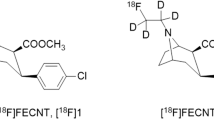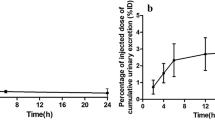Abstract
Technetium-99m is the most commonly used radionuclide in routine nuclear medicine imaging procedures. Development of99mTc-labeled receptor-specific imaging agents for studying the central nervous system is potentially useful for evaluation of brain function in normal and disease states. A novel99mTc-labeled tropane derivative, [99mTc]TRODAT 1, which is useful as a potential CNS dopamine transporter imaging agent, was evaluated and characterized. After i.v. injection into rats, [99mTc]TRODAT-1 displayed specific brain uptake in the rat striatal region (striatum-cerebellum/cerebellum ratio 1.8 at 60 min), where dopamine neurons are concentrated. The specific striatal uptake could be blocked by pretreating rats with a dose of competing dopamine transporter ligand, ß-CIT (or RTI-55, i.v., 1 mg/kg). However, the specific striatal uptake of [99mTc]TRODAT-] was not affected by co-injection of excess free ligand (TRODAT-1, up to 200 μg per rat) or by pretreating the rats with haloperidol (i.v., 1 mg/kg). The specific uptake in striatal regions of rats that had prior 6-hydroxydopamine lesion in the substantia nigra area showed a dramatic reduction. The radioactive material recovered from the rat striatal homogenates at 60 min after i.v. injection of [99mTc]TRODAT-1 showed primarily the original compound (>95%), a good indication of in vivo stability in brain tissue. Similar and comparable organ distribution patterns and brain regional uptakes of [99mTc]TRODAT-1 were obtained for male and female rats. Ex vivo autoradiography results of rat brain sections further confirmed the high uptake and retention of [99mTc]TRODAT-1 in the striatal region. In vitro binding studies measuring the affinity to dopamine transporters for the free ligand, TRODAT-1, and a nonradioactive rhenium derivative, Re-TRODAT-1, showed K i values of 9.7 nM and 14.1 nM, respectively. Behavioral studies in rats using the free ligand, TRODAT-1 and Re-TRODAT-1 indicated that, unlike other tropane derivatives, they displayed no effect on locomotor activity, suggesting low toxicity. These results strongly support the conclusions that this novel99mTc radioligand binds selectively to dopamine transporters in the brain and that is is potentially useful for in vivo assessment of the loss of dopamine neurons in Parkinson's and other neurodegeneralive diseases.
Similar content being viewed by others
References
Kuhar MJ, Sanchez-Roa PM, Wong DF, Dannals RF, Grigoriadis DE, Lew R, Milberger M. Dopamine transporter: biochemistry, pharmacology and imaging.Eur Neurol 1990; 30 Suppl 1: 15–20.
Shimada S, Kitayama S, Lin C-L, Patel A, Nanthakumar E, Gregor P, Kuhar M, Uhl G. Cloning and expression of a cocaine-sensitive dopamine transporter complementary DNA.Science 1991; 254: 576–277.
Kaufman MJ, Madras BK. Severe depletion of cocaine recognition sites associated with the dopamine transporter in Parkinson's diseased striatum.Synapse 1991; 49: 43–49.
Allard P, Alafuzoff I, Carlsson A, Erikson K, Ericson E, Gottfries CG, Marcusson JO. Loss of dopamine uptake sites labeled with [3H]GBR-12935 in Alzheimer's disease.Eur Neurol 1990; 30: 181–185.
Fearnley JM, Less AJ. Aging and Parkinson's disease: substantia nigra regional selectivity.Brain 1991; 114: 2283–2301.
Volkow ND, Fowler JS, Gatley SJ, Logan J, Wang G-J, Ding Y-S, Dewey S. PET evaluation of the dopamine system of the human brain.J Nucl Med 1996; 37: 1242–1253.
Frost JJ, Rosier AJ, Reich SG, Smith JS, Ehlers MD, Snyder SH, Ravert HT, Dannals RF Positron emission tomographic imaging of the dopamine transporter with [11C]-WIN 35428 reveals marked declines in mild Parkinson's disease.Ann Neurol 1993; 34: 423–431.
Laihinen AO, Rinne JO, Nägren K et al. PET studies on brain monoamine transporters with carbon-11-ß-CIT in Parkinson's disease.J Nucl Med 1995; 36: 1263–1267.
Aquilonius S-M, Bergström K, Eckernäs S-Å, Hartvig P, Leenders KL, Lundquist H, Antoni G, Gee A, Rimland A, Ulin J, Långström B. In vivo evaluation of striatal dopamine re-uptake sites using [11C]nomifensine and positron emission tomography.Acta Neurol Scand 1987, 76: 283.
Seibyl JP, Marek KL, Quinlan D, Sheff K, Zoghbi S, Zea-Ponce Y, Baldwin RM, Fussel B, Smith EO, Charney DS. Decreased single-photon emission computed tomographic [123I]beta-CIT striatal uptake correlates with symptom severity in Parkinson's disease.Ann Neurol 1995; 38: 589–598.
Innis RB, Seibyl JP, Scanley BE et al. Single photon emission computed tomographic imaging demonstrates loss of striatal dopamine transporters in Parkinson's disease. Proc Natl Acad Sci USA 1993; 90: 11965–11969.
Shaya EK, Scheffel U, Dannals RF, Ricaurte GA, Carroll FI, Wagner HN Jr, Kuhar MJ, Wong DE In vivo imaging of dopamine reuptake sites in the primate brain using single photon emission computed tomography (SPECT) and iodine-123 labeled RTI-55.Synapse 1992; 10: 169–172.
Kung M-P, Essman WD, Frederick D, Meegalla S, Goodman M, Mu M, Lucki I, Kung HE IPT: a novel iodinated ligand for the CNS dopamine transporter.Synapse 1995; 20: 316–324.
Malison RT, Vessotskie JM, Kung M-P, McElgin W, Romaniello G, Kim H-J, Goodman MM, Kung HF Striatal dopamine transporter imaging in nonhuman primates with iodine-123-IPT SPECT.J Nucl Med 1995; 36: 2290–2297.
Mozley PD, Stubbs JB, Kim H-J, McElgin W, Kung M-P, Meegalla S, Kung HE Dosimetry of an iodine-123-labeled tropane to image dopamine transporters.J Nucl Med 1996; 37: 151–159.
Neumeyer JL, Wang S, Gao Y, Milius RA, Kula NS, Campbell A, Baldessarini RJ, Zea-Ponce Y, Baldwin RM, Innis RB. N-ω-Fluoroalkyl analogs of (1R)-2β-carbomethoxy-3β-(4-iodophenyl)-tropane (β-CIT): radiotracers for positron emission tomography and single photon emission computed tomography imaging of dopamine transporters.J Med Chem 1994; 37: 1558–1561
Kuikka JT, Akerman K, Bergstrom KA, Karhu J, Hiltunen J, Haukka J, Heikkinen J, Tiihonen J, Wang S, Neumeyer JL. Iodine-123-labeledN-(2-fluoroethyl)-2β-carbomethoxy-3β-(4-iodophenyl)nortropane for dopamine transporter imaging in the living human brain.Eur J Nucl Med 1995; 22: 682–686.
Abi-Dargham A, Gandelsman MS, DeErausquin GA, Zea-Ponce Y, Zoghbi SS, Baldwin RM, Laruelle M, Charney DS, Hoffer PB, Neumeyer JL, Innis RB. SPECT imaging of dopamine transporters in human brain with iodine- 123-fluoroalkyl analogs of ß-CIT.J Nucl Med 1996; 37: 1129–1133.
Fowler JS, Volkow ND, Wolf AP, Dewey SL, Schlyer DJ, Macgregor RR, Hitzemann R, Logan J, Bendriem B, Galley SJ. Mapping cocaine binding sites in human and baboon brain in vivo.Synapse 1989; 4: 371–377.
Meegalla SK, Plössl K, Kung M-P, Chumpradit S, Stevenson DA, Frederick D, Kung HF. Tc-99m labeled tropanes as dopamine transporter imaging agents.Bioconj Chem 1996; 7: 421–429.
Meegalla SK, Plössl K, Kung M-P, Chumpradit S, Stevenson DA, Kushner SA, McElgin WT, Mozley PD, Kung HE Synthesis and characterization of Tc-99m labeled tropanes as dopamine transporter imaging agents.J Med Chem 1997; 40: 9–17.
Kung HF, Frederick D, Kim H-J, McElgin W, Kung M-P, Mu M, Mozley PD, Stevenson DA, Kushner SA, Zhuang Z-P. In vivo SPECT imaging of 5-HT1A receptors with [123I]p-MPPI in nonhuman primates.Synapse 1996; 24: 273–281.
Kung HF, Kim H-J, Kung M-P, Meegalla SK, Plössl K, Lee H-K. Imaging of dopamine transporters in humans with technetium-99m TRODAT-1.Eur J Nucl Med 1996; 23: 1527–1530.
Clarke RL, Heckeler ML, Gambino AJ, Daum SJ, Harding HR, Pierson AK, Teiger DG, Pearl J, Shargel LD, Goehl TJ. (Exo,exo)-2-aryltropane3-carboxylic esters, hypoglycemic agents with accompanying analgesic activity.J Med Chem 1978; 21: 1243–1253.
Clarke RL, Bambino AJ, Pierson AK, Daum SJ. (2-Exo-3-endo)-2-aryltropane-3-carboxylic esters, a new class of narcotic antagonists.J Med Chem 1978; 21: 1235–1242.
Neve KA, Altar A, Wone CA, Marshall JF. Quantitative analysis of [3H]spiroperidol binding to rat forebrain sections: plasticity of neostriatal dopamine receptors after nigrostriatal injury.Brain Res 1984; 302: 9–18.
Munson PJ, Rodbard D. LIGAND: a versatile computerized approach for characterization of ligand binding system.Anal Biochem 1980; 107: 220–239.
Essman WD, McGonigle P, Lucki I. Anatomical differentiation within the nucleus accumbens of the locomotor stimulatory actions of selective dopamine agonists andd-amphetamine.Psychopharmacology 1993; 112: 233–241.
Rivest R, Falardeau P, DiPaolo T. Brain dopamine transporter: gender differences and effect of chronic haloperidol.Brain Res 1995; 692: 269–272.
Lever SZ, Baidoo KE, Mahmood A, Matsumura K, Scheffel UA, Wagner HN Jr. Novel technetium ligands with affinity for the muscarinic cholinergic receptor.Nucl Med Biol 1994; 21: 157–164.
Del Rosario RB, Jung Y-W, Baidoo KE, Lever SZ, Wieland DM. Synthesis and in vivo evaluation of a [99m/99Tc]-DADT-benzovesamicol: a potential marker for cholinergic neurons.Nucl Med Biol 1994; 21: 197–203.
Chi DY, O'Neil JP, Andernson CJ, Welch MJ, Katzenellenbogen JA. Homodimeric and heterodimeric bis(aminothiol) oxometal complexes with rhenium(V) and technetium(V). Control of heterodimeric complex formation and an approach to metal complexes that mimic steroid hormones.J Med Chem 1994; 37: 928–937.
DiZio JP, Anderson CJ, Davison A, Ehrhardt GJ, Carlson KE, Welch MJ, Katzenellenbogen JA. Technetium- and rhenium-labeled progestins: synthesis, receptor binding and in vivo distribution of an 11-ß-substituted progestin labeled with technetium-99 and rhenium-186.J Nucl Med 1992; 33: 558–569.
O'Neil JP, Wilson SR, Katzenellenbogen JA. Preparation and structural characterization of monoamine-monoamide bis(thiol) oxo complexes of technetium(V) and rhenium(V).Inorg Chem 1994; 33: 319–323.
Madras BK, Jones AG, Mahmood A, Zimmerman RE, Garada B, Holman BL, Davison A, Blundell P, Meltzer PC. Technepine: a high affinity technetium-99m probe to label the dopamine transporter in brain by SPECT imaging.Synapse 1996; 22: 239–246.
Mennicken F, Savasta M, Peretti-Renucci R, Feuerstein C. Autoradiographic localization of dopamine uptake sites in the rat brain with [3H]-GBR 12935.J Neural Transm 1992; 87: 1–14.
Kaufman MJ, Madras BK. Distribution of cocaine recognition sites in monkey brain. II. Ex vivo autoradiography with [3H]CFT and [125I]RTI-55.Synapse 1992; 12: 99–111.
Seibyl JP, Laruelle MA, Van Dyck CH, Wallace E, Baldwin RM, Zoghbi SS, Zea-Ponce Y, Neumeyer JL, Charney DS, Hoffer PB, Innis RB. Reproducibility of iodine-123-β-CIT SPECt brain measurement of dopamine transporters.J Nucl Med 1996; 37: 222–228.
Meegalla SK, Plössl K, Kung M-P, Stevenson DA, Liable-Sands LM, Rheingold AL, Kung HF. First example of a Tc-99m complex as a dopamine transporter imaging agent.J Am Chem Soc 1994; 117: 11037–11038.
Chugani DC, Ackermann RF, Phelps ME. In vitro [3H]spiperone binding: evidence for accumulation in corpus striatum by agonist-mediated receptor internalization.J Cereb Blood Flow Metab 1988; 8: 291–303.
Ebersole BJ, Weinstein H, Maayani S. Differences ind[3H]lysergic acid diethylamide binding in mouse cortex and hippocampus in vivo and in vitro revealed by radioautography and rapid filtration studies. J Pharmacol Exp Ther 1984; 229: 865–871.
Kuczenski R, Segal DS, Aizenstein ML. Amphetamine, cocaine and fencafamine: relationship between locomotor and stereotype response profiles and caudate and accumbens dopamine dynamics. J Neurosci 1991; 11: 2703–2712.
Author information
Authors and Affiliations
Rights and permissions
About this article
Cite this article
Kung, MP., Stevenson, D.A., Plössl, K. et al. [99mTc]TRODAT-1: A novel technetium-99m complex as a dopamine transporter imaging agent. Eur J Nucl Med 24, 372–380 (1997). https://doi.org/10.1007/BF00881808
Received:
Revised:
Issue Date:
DOI: https://doi.org/10.1007/BF00881808




